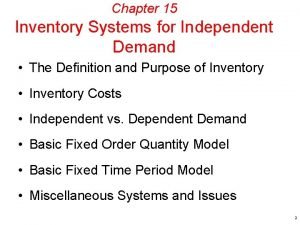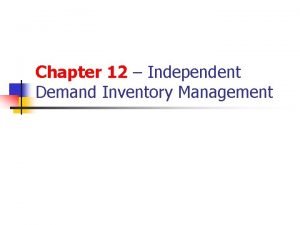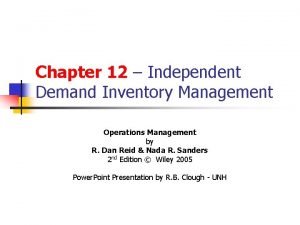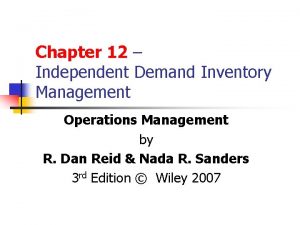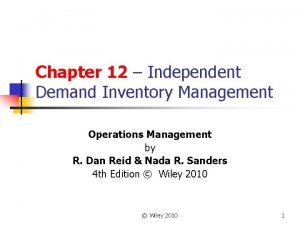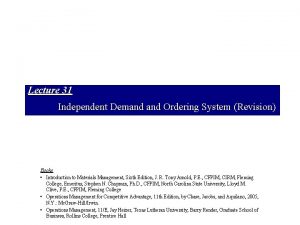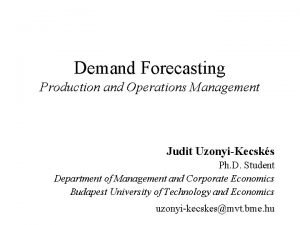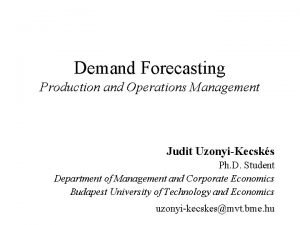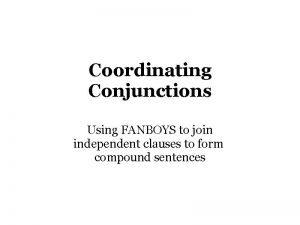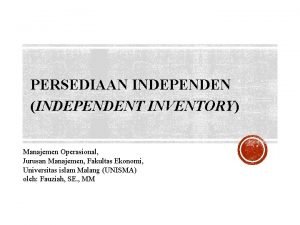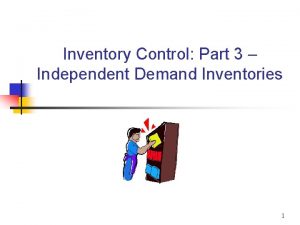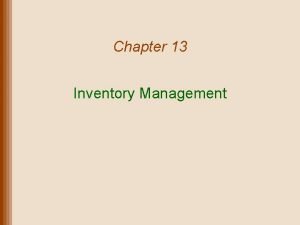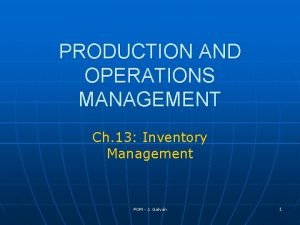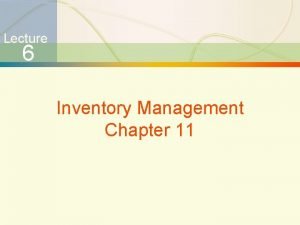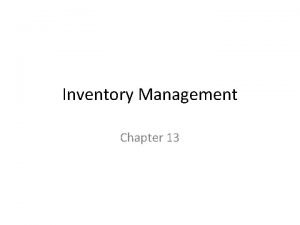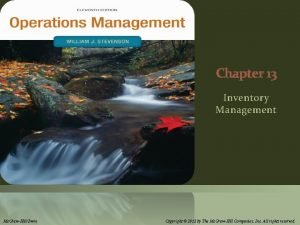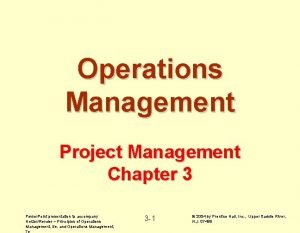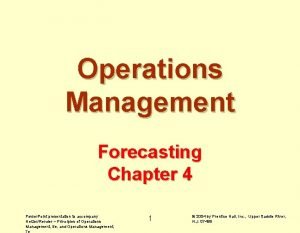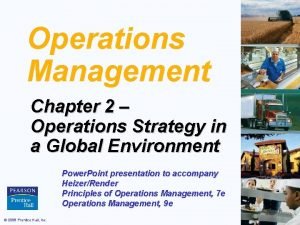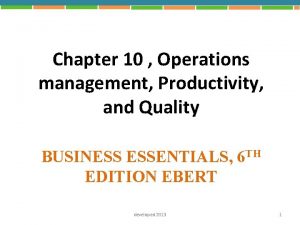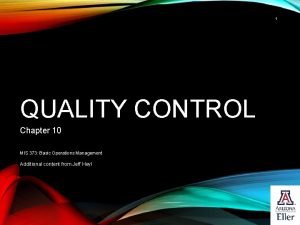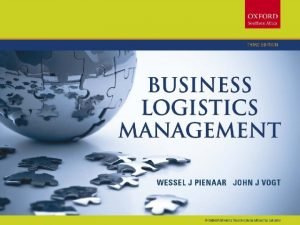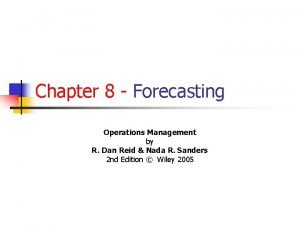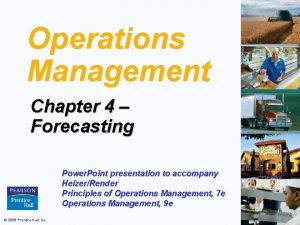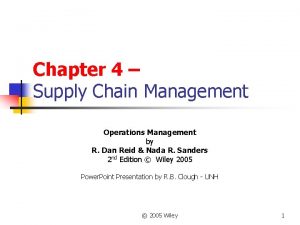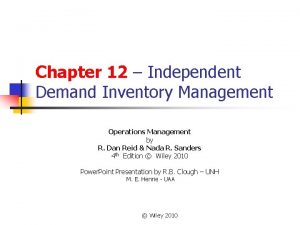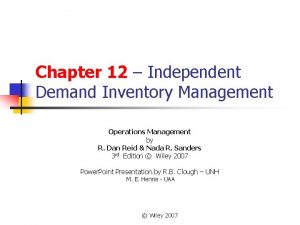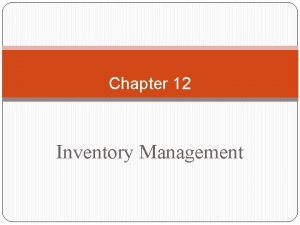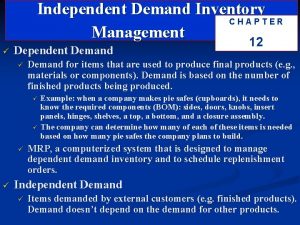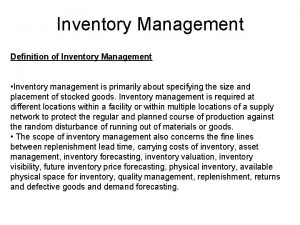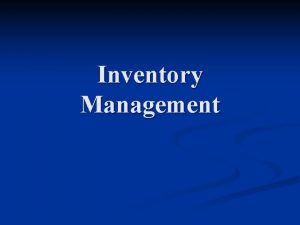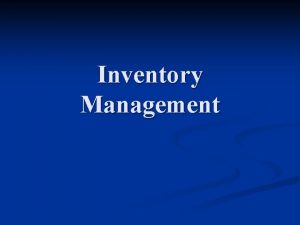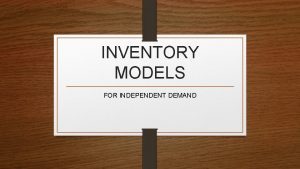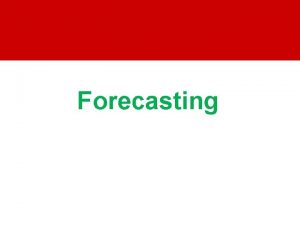Chapter 12 Independent Demand Inventory Management Operations Management












































- Slides: 44

Chapter 12 – Independent Demand Inventory Management Operations Management by R. Dan Reid & Nada R. Sanders 4 th Edition © Wiley 2010 1

Learning Objectives n n n Describe the different types and uses of inventory Describe the objectives of inventory management Calculate inventory performance measures Understand relevant costs associated with inventory Perform ABC inventory control & analysis Understand the role of cycle counting in inventory record accuracy © Wiley 2010 2

Learning Objectives – con’t n n n n Understand inventory’s role in service organizations Calculate order quantities Evaluate the total relevant costs of different inventory policies Understand why companies don’t always use the optimal order quantity Understand how to justify smaller order sizes Calculate appropriate safety stock inventory policies Calculate order quantities for single-period inventory © Wiley 2010 3

Types of Inventory n n n Raw materials– purchased items or extracted materials transformed into components or products Components – parts or subassemblies used in final product Work-in-process – items in process throughout the plant Finished goods – products sold to customers Distribution inventory – finished goods in the distribution system © Wiley 2010 4

Types of Inventory © Wiley 2010 5

How Companies Use Their Inventory 1. 2. 3. 4. 5. 6. Anticipation or seasonal inventory Fluctuation Inventory or Safety stock: buffer demand fluctuations Lot-size or cycle stock: take advantage of quantity discounts or purchasing efficiencies Transportation or Pipeline inventory Speculative or hedge inventory protects against some future event, e. g. labor strike Maintenance, repair, and operating (MRO) inventories © Wiley 2010 6

Objectives of Inventory Management Provide desired customer service level n n Percentage of orders/line items/$ volume shipped on schedule Idle time due to material and component shortages Provide for cost-efficient operations: n n n Buffer stock for smooth production flow Maintain a level work force Allowing longer production runs & quantity discounts Minimum inventory investments: n n Inventory turnover Weeks, days, or hours of supply © Wiley 2010 7

Customer Service Level Examples n Percentage of Orders Shipped on Schedule n n n Percentage of Line Items Shipped on Schedule n n n Good measure if orders have similar value. Does not capture value. If one company represents 50% of your business but only 5% of your orders, 95% on schedule could represent only 50% of value Recognizes that not all orders are equal, but does not capture $ value of orders. More expensive to measure. Ok for finished goods. A 90% service level might mean shipping 225 items out of the total 250 line items totaled from 20 orders scheduled Percentage Of Dollar Volume Shipped on Schedule n Recognizes the differences in orders in terms of both line items and $ value © Wiley 2010 8

Inventory Investment Measures Example: The Coach Motor Home Company has annual cost of goods sold of $10, 000. The average inventory value at any point in time is $384, 615. Calculate inventory turnover and weeks/days of supply. n Inventory Turnover: n Weeks/Days of Supply: © Wiley 2010 9

Two Forms of Demand n Dependent n n n Demand for items used to produce final products Tires stored at a Ford plant are an example of a dependent demand item Independent n n n Demand for items used by external customers Tires at a local tire dealer Cars, appliances, computers, and houses are examples of independent demand inventory

ABC Inventory Classification ABC classification is a method for determining level of control and frequency of review of inventory items n A Pareto analysis can be done to segment items into value categories depending on annual dollar volume n A Items – typically 20% of the items accounting for 80% of the inventory value-use Q system n B Items – typically an additional 30% of the items accounting for 15% of the inventory value-use Q or P n C Items – Typically the remaining 50% of the items accounting for only 5% of the inventory value-use P © Wiley 2010 11

The AAU Corp. is considering doing an ABC analysis on its entire inventory but has decided to test the technique on a small sample of 15 of its SKU’s. The annual usage and unit cost of each item is shown below © Wiley 2010 12

(A) First calculate the annual dollar volume for each item © Wiley 2010 13

B) List the items in descending order based on annual dollar volume. (C) Calculate the cumulative annual dollar volume as a percentage of total dollars. (D) Classify the items into groups © Wiley 2010 14

Graphical solution for AAU Corp showing the ABC classification of materials n n The A items (106 and 110) account for 60. 5% of the value and 13. 3% of the items The B items (115, 105, 111, and 104) account for 25% of the value and 26. 7% of the items The C items make up the last 14. 5% of the value and 60% of the items How might you control each item classification? Different ordering rules for each? © Wiley 2010 15

Inventory Record Accuracy n Inaccurate inventory records can cause: n n n Lost sales Disrupted operations Poor customer service Lower productivity Planning errors and expediting © Wiley 2010 16

Inventory Record Accuracy Two methods for checking record accuracy: n Periodic counting - physical inventory is taken periodically, usually annually n Cycle counting - daily counting of prespecified items provides the following advantages: n n n Timely detection and correction of inaccurate records Elimination of lost production time due to unexpected stock outs Structured approach using employees trained in cycle counting © Wiley 2010 17

Inventory Control Systems n Continuous system (fixed-order-quantity) n n Periodic system (fixed-time-period) n n constant amount ordered when inventory declines to predetermined level order placed for variable amount after fixed passage of time Decisions: How much to order (Q) and/or when to order (T)

Determining Order Quantities © Wiley 2010 19

Mathematical Models for Determining Order Quantity n Economic Order Quantity (EOQ) n n n Economic Production Quantity (EPQ) n n An optimizing method used for determining order quantity and reorder points Part of continuous review system which tracks onhand inventory each time a withdrawal is made A model that allows for incremental product delivery Quantity Discount Model n Modifies the EOQ process to consider cases where quantity discounts are available © Wiley 2010 20

EOQ Assumptions n Demand is known & constant - no n n n safety stock is required Lead time is known & constant No quantity discounts are available Ordering (or setup) costs are constant All demand is satisfied (no shortages) The order quantity arrives in a single shipment © Wiley 2010 21

Inventory Costs Item Cost Holding Costs Ordering Cost Shortage Costs Price paid for the item plus other direct costs associated with the purchase, $C/unit. Annual cost of holding an item in inventory, $H/unit/year Fixed, constant dollar amount incurred for each order placed, $S/order. Loss of customer goodwill, back order handling, and lost sales. © Wiley 2010 22

Total Annual Inventory Cost with EOQ Model Total annual cost= annual ordering cost + annual holding costs © Wiley 2010 23

Continuous (Q) Review System Example: A computer company has annual demand of 10, 000. They want to determine EOQ for circuit boards which have an annual holding cost (H) of $6/unit, and an ordering cost (S) of $75. They want to calculate TC and the reorder point (R) if the purchasing lead time is 5 days. n EOQ (Q) n Reorder Point (R) n Total Inventory Cost (TC) © Wiley 2010 24

Economic Production Quantity (EPQ) Same assumptions as the EOQ except: inventory arrives in increments & draws down as it arrives © Wiley 2010 25

Calculating EPQ n Total cost: n Maximum inventory: n n n d=avg. daily demand rate p=daily production rate Calculating EPQ © Wiley 2010 26

EPQ Problem: The demand for HP Ltd. ’s premium plant food is 100, 000 lbs/week. They operate 50 wks/year; HP produces 250, 000 lbs/week. Setup cost is $200 and the annual holding cost rate is $. 011/pound. Calculate the EPQ. Determine the maximum inventory level. Calculate the total cost of using the EPQ policy. © Wiley 2010 27

Quantity Discount Model n Same as the EOQ model, except: n n Unit price depends upon the quantity ordered The total cost equation becomes:

Quantity Discount Model (cont. ) TC = ($10 ) ORDER SIZE 0 - 99 100 – 199 200+ PRICE $10 8 (d 1) 6 (d 2) TC (d 1 = $8 ) Inventory cost ($) TC (d 2 = $6 ) Carrying cost Ordering cost Q(d 1 ) = 100 Qopt Q(d 2 ) = 200

Quantity Discount Procedure n n n n Calculate the EOQ at the lowest price Determine whether the vendor will sell that order quantity at that price (a. k. a. feasible EOQ) If yes, stop. It is the optimal quantity. Otherwise, Check the feasibility of EOQ at the next higher price until you identify a feasible EOQ Calculate the total costs (including total item cost) for the feasible EOQ model Calculate the total costs of buying at the minimum quantity required for each of the cheaper unit prices Compare the total cost of each option & choose the lowest cost alternative

Quantity Discount Example: Collin’s Sport store is considering going to a different hat supplier. The present supplier charges $10/hat and requires minimum quantities of 490 hats. The annual demand is 12, 000 hats, the ordering cost is $20, and the inventory carrying cost is 20% of the hat cost, a new supplier is offering hats at $9 in lots of 4000. Who should he buy from? n n n EOQ at lowest price $9. Is it feasible? Since the EOQ of 516 is not feasible, calculate the total cost (C) for each price to make the decision 4000 hats at $9 each saves $19, 320 annually. Space? © Wiley 2010 31

Justifying Smaller Order Quantities JIT or “Lean Systems” would recommend reducing order quantities to the lowest practical levels n Benefits from reducing Q’s: n n n Improved customer responsiveness (inventory = Lead time) Reduced Cycle Inventory Reduced raw materials and purchased components Justifying smaller EOQ’s: Reduce Q’s by reducing setup time (S). “Setup reduction” is a well documented, structured approach to reducing S © Wiley 2010 32

Additional Definitions n Lead Time, L n n Safety stock, SS n n buffer added to on hand inventory during lead time Stockout n n Time between an order is placed and the order is received an inventory shortage Order cycle service level n probability that the inventory available during lead time will meet demand

Inventory level Reorder Point with Safety Stock Q Reorder point, R Safety Stock 0 LT LT Time

Reorder Point With Variable Demand for Continuous Review, Q, System where * R = d. L + Z d L d = average demand (days/weeks/year) L = lead time (days/weeks/year) d = the standard deviation of demand (days/wks/yr) Z = number of standard deviations corresponding to the service level probability e. g. 95% service level (stockout risk of 5%) has a Z=1. 645 z d L = safety stock, SS Note : Order quantity is EOQ, Q*.

Continuous Review Example: AAA. Inc. has annual demand of 10, 000 units. Annual holding cost (H) is $6/unit and the ordering cost (S) is $75. Lead time is 5 days. Assume AAA, Inc. is open for 50 weeks and 5 days/week. Desired service level is 95% and the daily standard deviation, , is 2 units. Note Q*= 500 units. Determine the reorder point. R = d. L + Z d L = 40*5 + 1. 645*2 5 = 207 units. What is the average inventory level for this system? Suggest two ways in which AAA can reduce inventory costs.

Periodic Review Systems n n Orders are placed at specified, fixed-time intervals (e. g. every Friday), for a order size (Q) to bring on-hand inventory (OH) up to the target inventory (TI), similar to the min-max system. Advantages are: n n n No need for a system to continuously monitor item Items ordered from the same supplier can be reviewed on the same day saving purchase order costs Disadvantages: n n n Replenishment quantities (Q) vary Order quantities may not quality for quantity discounts On the average, inventory levels will be higher than Q Wiley 2010 needed 37 systems-more stockroom© space

Periodic Review Systems: Calculations for TI n n Targeted Inventory level, TI: TI = d (RP + L) + Z RP+L where d = average period demand (days, wks) RP = review period (days, wks) L = lead time (days, wks) Replenishment Quantity (Q)=TI-OH, where OH = on-hand inventory level

Periodic Review Example: AAA. Inc. has annual demand of 10, 000 units. Annual holding cost (H) is $6 per unit and ordering cost (S) is $75. Lead time is 5 days. Assume AAA, Inc. is open for 50 weeks and 5 days/week. Desired service level is 95% and the daily standard deviation, , is 2 units. Note Q*= 500 units. n Review Period, RP n Target Inventory for 95% Service Level

Single Period Inventory Model The SPI model is designed for products that share the following characteristics: n n Sold at their regular price only during a single-time period Demand is highly variable but follows a known probability distribution Salvage value is less than its original cost so money is lost when these products are sold for their salvage value Objective is to balance the gross profit of the sale of a unit with the cost incurred when a unit is sold after its primary selling period © Wiley 2010 40

SPI Model Example: T-shirts are purchase in multiples of 10 for a charity event for $8 each. When sold during the event the selling price is $20. After the event their salvage value is just $2. From past events the organizers know the probability of selling different quantities of t-shirts within a range from 80 to 120 Payoff Prob. Of Occurrence Customer Demand # of Shirts Ordered 80 90 Buy 100 110 120 . 20 80 $960 $900 $840 $780 $720 Table . 25 90 . 30 100 . 15 110 . 10 120 $960 $1080 $1020 $ 960 $ 900 $960 $1080 $1200 $1140 $1080 $960 $1080 $1200 $1320 $1260 $960 $1080 $1200 $1320 $1440 Profit $960 $1040 $1083 $1068 $1026 Sample calculations: Payoff (Buy 110)= sell 100($20 -$8) –((110 -100) x ($8 -$2))= $1140 Expected Profit (Buy 100)= ($840 X. 20)+($1020 x. 25)+($1200 x. 30) + ($1200 x. 15)+($1200 x. 10) = $1083 © Wiley 2010 41

Single Period Inventory Model n n n Selling Price, SP; Cost Price = CP; Salvage Value, SV Cost of understocking, Cu = SP – CP = 20 -8 = $ 12 Cost of overstocking, Co = CP – SV = 8 -2 = $6 Optimal probability P(n < x) Cu 12 = =. 667 Cu + Co 12 + 6 Demand Prob. P(n<x) 80 0. 20 0 90 0. 25 0. 20 100 0. 30 0. 45 110 0. 15 0. 75 120 0. 10 0. 90

Chapter 12 Highlights n n Raw materials, purchased components, work-in -process, finished goods, distribution inventory and maintenance, repair and operating supplies are all types of inventory. The objectives of inventory management are to provide the desired level of customer service using minimum inventory investment. Relevant inventory costs include item costs, holding costs, and shortage costs. The ABC classification system allows a company to assign the appropriate level of control & frequency of review of an item based on its annual $ volume. © Wiley 2010 43

Chapter 12 Highlights (con’t. ) n n Lot-for-lot, fixed-order quantity, min-max systems, order n periods, periodic review systems, EOQ models, quantity discount models, and single-period models can be used to determine order quantities. Smaller lot sizes give a company flexibility and shorter response times. The key to reducing order quantities is to reduce ordering or setup costs. Calculating the appropriate safety stock policy enables companies to satisfy their customer service objective at minimum costs. The desired customer service level determines the appropriate z value. Inventory decisions about perishable products can be made using the single-period inventory model. The expected payoff is calculated to assist the quantity decision. © Wiley 2010 44
 Independent vs dependent demand
Independent vs dependent demand Dependent vs independent demand
Dependent vs independent demand Independent demand
Independent demand Inventory models for independent demand
Inventory models for independent demand Dependent and independent demand in inventory management
Dependent and independent demand in inventory management Independent demand meaning
Independent demand meaning Independent demand examples
Independent demand examples Chapter 12 inventory management
Chapter 12 inventory management Inventory models for independent demand
Inventory models for independent demand Inventory models for independent demand
Inventory models for independent demand Demand service
Demand service Forecasting in operations management
Forecasting in operations management Tracking signal
Tracking signal Two main clauses
Two main clauses Objective of merchandising
Objective of merchandising Rumus eoq
Rumus eoq Independent demand meaning
Independent demand meaning Deterministic and stochastic inventory models
Deterministic and stochastic inventory models Fiscal measures to correct deficient demand
Fiscal measures to correct deficient demand Market demand curve
Market demand curve Supply schedule halimbawa
Supply schedule halimbawa Module 5 supply and demand introduction and demand
Module 5 supply and demand introduction and demand What is demand estimation in managerial economics
What is demand estimation in managerial economics Distinguish between individual demand and market demand
Distinguish between individual demand and market demand S&op in sap
S&op in sap Chapter 13 inventory management problems and solutions
Chapter 13 inventory management problems and solutions Chapter 13 inventory management
Chapter 13 inventory management Chapter 13 inventory management
Chapter 13 inventory management Chapter 13 inventory management
Chapter 13 inventory management Chapter 13 inventory management
Chapter 13 inventory management Operations management chapter 3 ppt
Operations management chapter 3 ppt Operations management chapter 4 forecasting solutions
Operations management chapter 4 forecasting solutions Operations management chapter 2
Operations management chapter 2 Operation manager function
Operation manager function Product design and process selection
Product design and process selection Operations management chapter 10
Operations management chapter 10 Asq control chart
Asq control chart Chapter 8 operations management
Chapter 8 operations management Forecasting in operations management
Forecasting in operations management Process strategy in operations management
Process strategy in operations management Operation management chapter 4
Operation management chapter 4 Chapter 11 operations management
Chapter 11 operations management What is job enrichment
What is job enrichment Chapter 4 operations management
Chapter 4 operations management Competitive operations strategy
Competitive operations strategy



